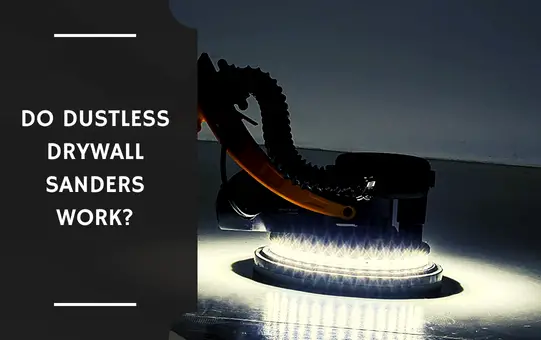When it comes to sanding drywall, the process can be messy and time-consuming. Traditional drywall sanders create a lot of dust, which can be a health hazard and requires a lot of clean-up.
Do Dustless Drywall Sanders Work?
Yes, dustless drywall sanders work. These devices are powered by high-pressure air and run for about 5 minutes. A dustless drywall sander will provide a smooth finish without any debris.
In this article, we’ll take a closer look at dustless drywall sanders and explore their features, benefits, and drawbacks.
See Also: Can You Use a Drywall Sander on Painted Walls?
Do Dustless Drywall Sanders Work? – Guide
Dustless drywall sanders are tools designed to sand drywall without creating a lot of dust.
They work by capturing the dust before it can become airborne, using a dust collection system.
This can include a vacuum or a dust bag attached to the sander itself. The idea is that by capturing the dust, the process of sanding drywall will be cleaner and healthier for the user.
How Do Dustless Drywall Sanders Work?
Dustless drywall sanders work by using a dust collection system to capture the dust before it can become airborne.
The dust collection system can be a vacuum or a dust bag attached to the sander itself.
As the sander is used to sand the drywall, the dust is sucked into the collection system, where it is trapped and can be disposed of safely.
Benefits of Dustless Drywall Sanders
The fact that dustless drywall sanders produce significantly less dust than conventional drywall sanders is one of their main advantages.
As a result, drywall sanding is easier and safer for the user. Less airborne dust means less chance of respiratory issues and less cleanup needed.
Dustless drywall sanders can also save time because they need less cleanup and can be used for longer periods of time without having to be emptied, which reduces the amount of time needed.
Drawbacks of Dustless Drywall Sanders
Although dustless drywall sanders have many advantages, there are some disadvantages to take into account.
The fact that they can be more expensive than conventional drywall sanders is one of their main disadvantages.
Additionally, some types of drywall, such as textured or painted drywall, may not respond as well to dustless drywall sander use.
Furthermore, it’s crucial to understand that while dustless drywall sanders do help to lessen airborne dust, they cannot completely do so. There will still be some dust produced, and it must be safely disposed of.

Maintenance and Care for Dustless Drywall Sanders
Dustless drywall sanders are an important tool for the home improvement and construction industry.
They are used to finish and smooth walls, ceilings, and other surfaces. Proper maintenance and care of these tools is essential for efficient and safe operation.
The most important maintenance practice for dustless drywall sanders is to ensure they are properly cleaned and lubricated after each use.
Dust particles can accumulate in the motor, and other components, and can cause the sander to become sluggish or clogged.
Regularly cleaning the sander with a brush or compressed air to remove the dust is key to keeping it operating effectively.
Additionally, lubricating the motor and other moving parts with a light oil will help keep the sander running smoothly and reduce the potential for wear and tear.
Another important practice is to check the power cord for any signs of damage or wear.
If any damage is present, it is important to replace the cord immediately to prevent electrical hazards.
Lastly, it is important to keep the sander stored in a clean and dry place, away from any moisture or extreme temperatures.
This will help minimize any potential damage to the sander and ensure it is ready for use anytime.
Tips for Using Dustless Drywall Sanders
Dustless drywall sanders can be a great tool for those looking to make quick work of sanding and smoothing the walls and ceilings in the home. Here are a few tips for using dustless drywall sanders:
- Wear protective gear: Always wear a dust mask and safety glasses when using a dustless drywall sander. The dust created can contain tiny particles that can be harmful if inhaled.
- Use the right type of paper: Purchase the right type of sandpaper for the job. The paper should be designed specifically for drywall sanders and should be coarse enough to remove the texture of the wall without damaging the drywall.
- Move the sander in a consistent pattern: When using a dustless drywall sander, it is important to move it in a consistent pattern. This will ensure that the wall is evenly and smoothly sanded, which will make the job easier and quicker in the long run.
- Use a vacuum or dust collection system: A dustless drywall sander often comes with a vacuum or dust collection system attachment. Make sure to connect it correctly for maximum efficiency.
- Keep the sander moving: It is important to keep the sander moving at all times. If the sander is stationary, it can create a groove in the wall, which can be difficult to repair.
Conclusion
Overall, dustless turbo drywall sanders can be a great option for those looking to make the process of sanding drywall cleaner and healthier.
They work by capturing the dust before it can become airborne and can save time on clean-up.
However, they can be more expensive than traditional drywall sanders and may not work as well on certain types of drywall.
I hope this blog post is helpful for you in understanding do dustless drywall sanders work.
Read Also: Can a Drywall Sander Be Used on Wood?
